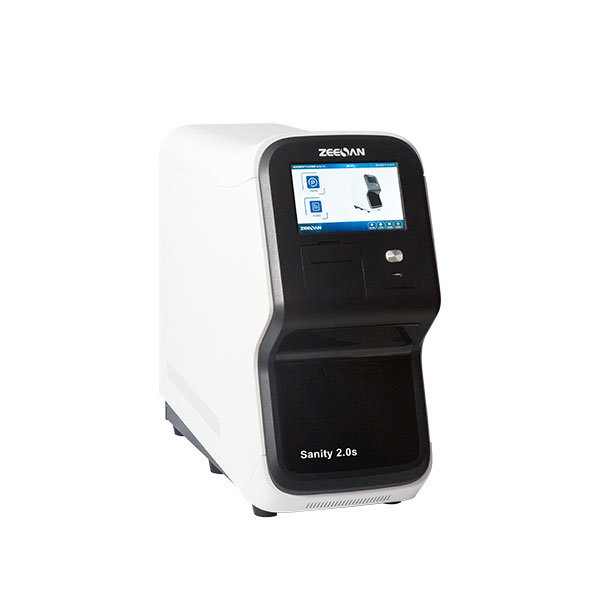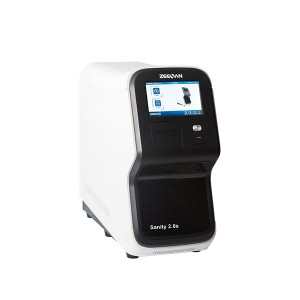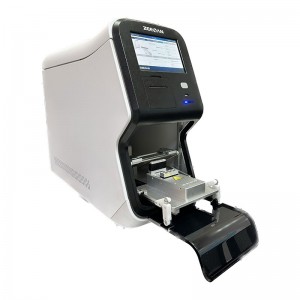
Product
Sanity 2.0s System
Based on the principle of real-time PCR detection, Sanity 2.0s System is designed to be used in combination with dedicated testing reagents for the clinical qualitative detection of target nucleic acids (DNA/RNA) from human samples, including pathogens and human genes.
The Sanity 2.0s System is an all-in-one molecular diagnostic platform designed for the detection of infectious diseases. It streamlines the process, covering nucleic acid extraction, real-time PCR preparation and detection, as well as data analysis. The operation is straightforward, with manual steps that take less than 5 minutes to complete. This system is engineered for efficiency and ease of use, minimizing the time and effort required for the user while maintaining the accuracy and reliability of molecular diagnostics.
A wide range of diagnostic tests can be run on Sanity 2.0s System, including tuberculosis (TB/MDR), NTM, respiratory pathogen panels (RPP), HPV, STI, etc. Please refer to the corresponding pages.
Principle
The automated processes inside the Sanity 2.0s System involves the following steps:
1.Nucleic Acid Extraction with Magnetic Beads:
The process begins with the extraction of nucleic acids using magnetic beads, which are designed to selectively bind to nucleic acids within the sample matrix.
The magnetic beads, once bound to the nucleic acids, are easily separated from other sample components through the application of a magnetic field, which pulls the beads to the side of the reaction vessel.
This step is crucial for obtaining a pure nucleic acid sample, free from contaminants that could interfere with the subsequent PCR reaction.
2.Transfer of Nucleic Acids and PCR Mix to PCR Module:
After the extraction, the machine automatically transfers the extracted and purified nucleic acid sample to the PCR module, where the PCR reaction will take place.
Along with the nucleic acid sample, a PCR mix is also transferred, the mix is either pre-loaded in the PCR catridge or the additional PCR tube, depending on the design of different kits. This mix contains a master mix, which is a pre-formulated solution containing all the necessary enzymes, salts, and other cofactors for the PCR reaction, as well as specific probes and primers that target the nucleic acid sequence of interest.
The PCR module is where the thermal cycling occurs, with precise temperature control facilitating the various stages of DNA amplification.
3.Initiation of Real-Time PCR Detection:
Real-time PCR detection commences with the amplification of the target nucleic acid sequence. This is achieved through a series of temperature changes that allow for DNA denaturation, primer annealing, and extension.
Throughout the amplification process, the machine monitors the reaction in real time, using a fluorescence detection system to measure the accumulation of amplified product. Fluorescent probes bind to the amplified DNA, and their signals increase as the target DNA accumulates.
The real-time monitoring allows for the quantification of the target nucleic acid and the identification of positive samples during the early cycles of amplification.
4.Melting Curve Analysis:
After amplification, the system increases the temperature gradually, and the fluorescence of the sample is monitored continuously. As the temperature rises, the double-stranded DNA will begin to denature, leading to a decrease in fluorescence. The melting temperature (Tm), the point at which half of the DNA molecules have denatured, is specific for each DNA sequence due to differences in sequence composition, such as GC content and length. Sanity 2.0s System’s software analyzes the melting curve data, identifying the presence or absence of the target sequence based on the Tm values.
5.Data Analysis:
After the PCR run is completed, the machine’s integrated software takes over, analyzing the data collected during the amplification and melting curve analysis.
The software compares the fluorescence signals to a predefined threshold to determine the presence or absence of the target nucleic acid and calculates the cycle threshold (Ct) values, which are indicative of the initial amount of nucleic acid in the sample. For the kits that are designed with MMCA technology, the software will analyze the Tm values based on melting curve analysis, to distinguish between different targets.
6.Reporting:
Once the data analysis is complete, the machine generates a comprehensive test report that includes all the relevant details of the PCR run, including sample identifiers, run details, and the results of the analysis.
This report can be easily exported or printed, facilitating the documentation and tracking of test results in accordance with laboratory protocols.
This fully automated system allows for the accurate and sensitive detection of specific nucleic acid sequences, which is crucial for the diagnosis of infectious diseases and other diseases.
Specifications
| Dimensions | 260 mm×540 mm×570 mm |
| Weight | 30 kg |
| Power Supply | AC 100 V-240 V, 50 Hz/60 Hz |
| Power | 600 VA |
| Sample Throughput | 1~4 samples |
| Sample Volume | 1 μL~2000 μL |
| Pipetting Range | 0 μL~200 μL |
| Pipetting Accuracy | ≤4% (25 μL) |
| Technology | Magnetic-particle technology |
| PCR Reaction System | 15 μL~100 μL |
| Heating Rate | ≥5.0℃/s |
| Cooling Rate | ≥3.5℃/s |
| Temperature Accuracy | ≤0.1℃ |
| Temperature Uniformity between Wells | ±0.1℃ |
| Applicable Probe / Dye | Channel 1: FAM / SYBR Green Channel 2: VIC / HEX / JOE / TET / TAMRA / Cy3 Channel 3: ROX / Texas Red Channel 4: CY5 |
| Disinfection Function | Time gated UV disinfection |
CE-IVD Marked
Interested to Know More about Our Solution to Molecular Diagnostics?



